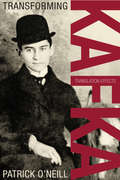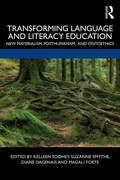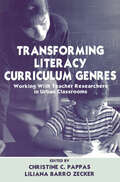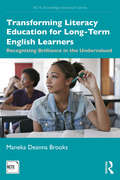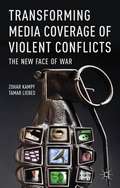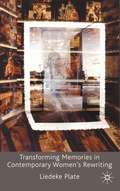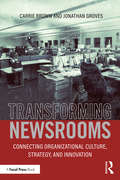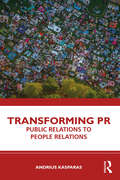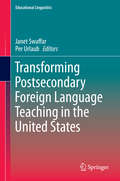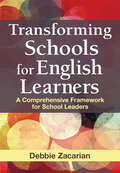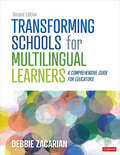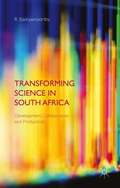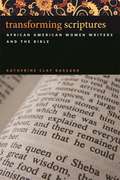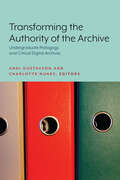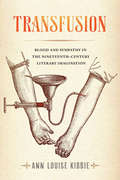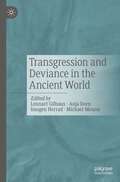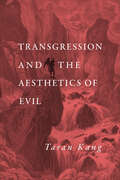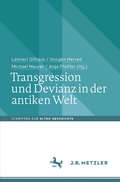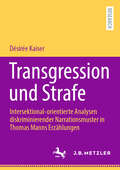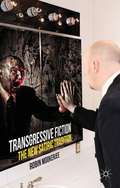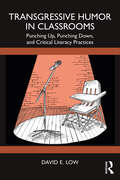- Table View
- List View
Transforming Kafka
by Patrick O'NeillLyrical, mysterious, and laden with symbolism, Franz Kafka's novels and stories have been translated into more than forty languages ranging from Icelandic to Japanese. In Transforming Kafka, Patrick O'Neill approaches these texts through the method he pioneered in Polyglot Joyce and Impossible Joyce, considering the many translations of each work as a single, multilingual "macrotext."Examining three novels - The Trial, The Castle, and America - and two short stories - "The Judgment" and "The Metamorphosis" - O'Neill offers comparative readings that consider both intertextual and intratextual themes. His innovative approach shows how comparing translations extends and expands the potential meanings of the text and reveals the subtle differences among the hundreds of translations of Kafka's work. A sophisticated analysis of the ways in which translation shapes, rearranges, and expands our understanding of literary works, Transforming Kafka is a unique approach to reading the works of a literary giant.
Transforming Language and Literacy Education: New Materialism, Posthumanism, and Ontoethics
by Kelleen TooheyThe field of languages and literacies education is undergoing rapid transformation. Scholarship that draws upon feminist, post-colonial, new material and posthuman ontologies is transcending disciplinary boundaries and disrupting traditional binaries between human and nonhuman, the natural and the cultural, the material and the discursive. In Transforming Language and Literacy Education, editors Kelleen Toohey, Suzanne Smythe, Diane Dagenais and Magali Forte bring together accessible, conceptually rich stories from internationally diverse authors to guide new practices, new conversations and new thinking among scholars and educators at the forefront of languages and literacies learning. The book addresses these concepts for diverse groups of learners including young children, youth and adults in formal educational and community-based settings. Challenging and disruptive, this is a unique and important contribution to language and literacy education.
Transforming Literacy Curriculum Genres: Working With Teacher Researchers in Urban Classrooms
by Christine C. Pappas Liliana ZeckerIn this volume, university researchers and urban elementary teacher-researchers coauthor chapters on the teachers' year-long inquiries, on a range of literacy topics that they conducted as part of a collaborative school-university action research project. Central to this project was the teacher-researchers' attempts to transform their teaching practices to meet the needs of students from diverse ethnic and linguistic backgrounds, and their finding that their inquiry efforts resulted in developing more collaborative styles of teaching. Because the everyday interactions between teachers and students are realized by the social talk in the classroom, the university- and teacher-researchers analyzed classroom discourse to study and document the teachers' efforts to make changes in the locus of power in literacy teaching and learning. The chapters include many classroom discourse examples to illustrate the critical points or incidents of these teachers' inquiries. They show the successes and the struggles involved in shedding teacher-controlled patterns of talk. This book explores the process of urban teachers' journeys to create dialogically organized literacy instruction in particular literacy routines--called, in this book, curriculum genres. The book is organized in terms of these curriculum genres, such as writing curriculum genres, reading-aloud curriculum genres, drama curriculum genres, and so forth. Teacher inquiries were conducted in various elementary grade levels, from kindergarten through grade eight. Three occurred in bilingual classrooms and one in a special education classroom. The first and last chapters, written by the editors, provide the background, theoretical, and methodological underpinnings of the project.
Transforming Literacy Education for Long-Term English Learners: Recognizing Brilliance in the Undervalued (NCTE-Routledge Research Series)
by Maneka Deanna BrooksGrounded in research on bilingualism and adolescent literacy, this volume provides a much-needed insight into the day-to-day needs of students who are identified as long-term English language learners (LTELs). LTELs are adolescents who are primarily or solely educated in the U.S. and yet remain identified as "learning English" in secondary school. Challenging the deficit perspective that is often applied to their experiences of language learning, Brooks counters incorrect characterizations of LTELs and sheds light on students’ strengths to argue that effective literacy education requires looking beyond policy classifications that are often used to guide educational decisions for this population. By combining research, theory, and practice, this book offers a comprehensive analysis of literacy pedagogy to facilitate teacher learning and includes practical takeaways and implications for classroom practice and professional development. Offering a pathway for transforming literacy education for students identified as LTELs, chapters discuss reframing the education of LTELs, academic reading in the classroom, and the bilingualism of students who are labeled LTELs. Transforming Literacy Education for Long-Term English Learners is a much-needed resource for scholars, professors, researchers, and graduate students in language and literacy education, English education, and teacher education, and for those who are looking to create an inclusive and successful classroom environment for LTELs.
Transforming Media Coverage of Violent Conflicts
by Zohar Kampf Tamar LiebesWhat links the interviews with Saddam Hussein and Mahmoud Ahmadinejad on British and American TV, the chase of journalists following mega-terrorists, and the new status conferred on ordinary people at war? Transforming Media Coverage of Violent Conflicts offers a timely and original discussion on the shift in war journalism in recent years.
Transforming Memories in Contemporary Women’s Rewriting
by Liedeke PlateIncluding topics as diverse as feminism and its relationship to the marketplace, plagiarism and copyright, silence and forgetting, and myth in a digital age, this book explores the role of rewriting within feminist literature from the 1970s onwards in relation to the theme of cultural memory.
Transforming Newsrooms: Connecting Organizational Culture, Strategy, and Innovation
by Carrie Brown Jonathan GrovesTransforming Newsrooms offers a practical guide to navigating structural and culture change for news organizations facing economic disruption in today’s rapidly changing media landscape. Even when the need for change is obvious, the best ideas and intentions are often not followed by successful execution. This book offers a road map for understanding the obstacles to change in news organizations and how to overcome them. Providing a detailed overview of the ways in which news processes and routines are being fundamentally altered to meet new demands for multimedia, interactivity, and immediacy, the book offers tips to help news organizations better serve communities by understanding what information people need and how they want to engage and collaborate. The book also features a variety of case studies and examples from news organizations of all kinds, including a 10-year in-depth investigation of the Christian Science Monitor, the first national news organization to stop its daily presses for a digital report. Transforming Newsrooms is an invaluable resource for students and media professionals alike, demonstrating how to make research on organizational change actionable and help build a more equitable journalism model that will survive and thrive when we need it most.
Transforming PR: Public Relations to People Relations
by Andrius KasparasThis book introduces the concept of the Picnic Society – a society which we all belong to today because social media has given us unlimited opportunities to create or destroy our own and our circle’s (our bubble’s) realities, possibilities, and reputations.In today’s world every organization is integrated into society, and the people belonging to organizations are integrated into various continually interacting communities. Social media has – or soon will – erase any remaining boundaries between organizations and the world’s social fabric. It is increasingly pointless for organizations to try to establish relationships with society, because these already exist – 24 hours per day, 7 days per week, and all 365 days of the year. This is what I mean in talking about the transformation of the field of PR – from Public Relations to People Relations. This book discusses the challenges facing public relations professionals working in a contemporary society that is flooded with information, offers endless channels of communication, gives rise to true and false leaders, and is marked by both openness and mistrust, by real and fake news.This book will appeal to professionals who already have a solid grasp of public relations technologies but would like to review their skills and develop their own model of public relations know-how without being limited by the strict boundaries of traditional PR theory.
Transforming Postsecondary Foreign Language Teaching in the United States
by Janet Swaffar Per UrlaubThis volume addresses critical challenges and issues facing foreign language departments in colleges and universities across the U. S. It presents the insights of individuals who have built or are in the process of building foreign language curricula during a major transition period in postsecondary institutions. The authors of this volume come from various language departments and institutional experience from across the U. S. , including private and public postsecondary foreign language teachers, researchers and administrators. The chapters address issues and provide templates for curricular change at all learning levels. The five sections of this book explore: Changing Perceptions about Foreign Language Learning; The Case for a Multi-literacy FL Curriculum in Concept and Assessment Praxis; Curricular Transformations: Historical Hurdles and Faculty Heuristics; Rethinking the Graduate Curriculum; Foreign Languages' Integration into the Interdisciplinary University. "This thought-provoking and timely volume addresses the question of how historic and current disciplinary, institutional and political conditions affect curricular transformation in collegiate foreign language programs. Responding to the issues raised in the 2007 MLA Report, this collection of nine essays presents a diversity of curricular models and approaches from different theoretical perspectives focusing on the integration of language and content. The book will undoubtedly be of great interest to a broad audience, such as foreign language educators, curriculum designers, administrators, graduate students and researchers. " Nelleke Van Deusen-Scholl, Yale College, CT, USA.
Transforming Schools for English Learners: A Comprehensive Framework for School Leaders
by Debbie ZacarianPosition your school to successfully teach English learners Could your school be more effective at instructing its English learners? Whether you are just beginning to work with an emergent population or need to improve your program, this book provides a comprehensive framework for improving ELs’ academic performance and school engagement through visionary planning of EL education programming. The author addresses such critical topics as: Selecting the appropriate program model for your school Creating effective student course schedules for language development and content Making data-driven decisions using effective measures of student performance learning Effectively using Response to Intervention (RTI)
Transforming Schools for Multilingual Learners: A Comprehensive Guide for Educators
by Debbie ZacarianEssential principles, practices, and structures for multilingual learners Much has changed in the ten years since this book was first published. A celebrated triumph, it provided state, district, school, and teacher leaders with a comprehensive guide to support multilingual learners to reach their full potential. From selecting the appropriate program model to partnering with families and infusing federal and state laws governing the education of multilingual learners and the rights of their families into all we do, the key messages that made the first edition of this book a renowned success have been re-examined in the second edition with a robust lens to meet these demanding times. This second edition supports educators to design and enact policies, practices, and structures for multilingual learners (MLs) to feel a sense of safety, belonging, value, and competence. Topics explored in the book include: a discussion of the changes to federal and state policies and their impact on MLs and their families strategies to move from a deficit- to an asset-based approach that values multilingualism nine principles to design and deliver high-quality lessons in multiple languages and across disciplines practices to identify and support MLs with learning differences and disabilitiessteps for building long-lasting family-school partnerships Reflecting changing trends in leadership, this new edition supports superintendents, principals, curriculum supervisors, coaches, mentors, teachers, and other stakeholders in their collaborative efforts to create and sustain successful language assistance programs.
Transforming Schools for Multilingual Learners: A Comprehensive Guide for Educators
by Debbie ZacarianEssential principles, practices, and structures for multilingual learners Much has changed in the ten years since this book was first published. A celebrated triumph, it provided state, district, school, and teacher leaders with a comprehensive guide to support multilingual learners to reach their full potential. From selecting the appropriate program model to partnering with families and infusing federal and state laws governing the education of multilingual learners and the rights of their families into all we do, the key messages that made the first edition of this book a renowned success have been re-examined in the second edition with a robust lens to meet these demanding times. This second edition supports educators to design and enact policies, practices, and structures for multilingual learners (MLs) to feel a sense of safety, belonging, value, and competence. Topics explored in the book include: a discussion of the changes to federal and state policies and their impact on MLs and their families strategies to move from a deficit- to an asset-based approach that values multilingualism nine principles to design and deliver high-quality lessons in multiple languages and across disciplines practices to identify and support MLs with learning differences and disabilitiessteps for building long-lasting family-school partnerships Reflecting changing trends in leadership, this new edition supports superintendents, principals, curriculum supervisors, coaches, mentors, teachers, and other stakeholders in their collaborative efforts to create and sustain successful language assistance programs.
Transforming Science in South Africa
by R. SooryamoorthyThis book is essential for anyone interested in knowing how science works nationally and internationally in the contemporary world. It offers a comprehensive analysis of scientific collaboration and its relation to development and the productivity of scientists, with specific reference to South Africa in both the past and the present.
Transforming Scriptures: African American Women Writers and the Bible
by Katherine Clay BassardTransforming Scriptures is the first sustained treatment of African American women writers’ intellectual, even theological, engagements with the book Northrop Frye referred to as the “great code” of Western civilization. Katherine Clay Bassard looks at poetry, novels, speeches, sermons, and prayers by Maria W. Stewart, Frances Harper, Hannah Crafts, Harriet E. Wilson, Harriet Jacobs, Zora Neale Hurston, Toni Morrison, and Sherley Anne Williams and discusses how such texts respond as a collective “literary witness” to the use of the Bible for purposes of social domination.
Transforming Texts (Routledge A Level English Guides)
by Shaun O'TooleTransforming Texts: considers why language changes, and how we transform it covers the key factors we need to take into account when transforming texts, including audience, register, mode, historical period, source and genre explores a wide variety of texts from a range of genres and periods, from Macbeth and Sense and Sensibility to Fever Pitch and The Bill offers a step-by-step guide to re-writing text; can be used as both a course text and a revision tool. Written by an experienced teacher, author and AS and A2 examiner, Transforming Texts is an essential resource for all students of AS and A2 level English Language and English Language and Literature.
Transforming the Authority of the Archive: Undergraduate Pedagogy and Critical Digital Archives
by Andi GustavsonFeaturing a wide array of perspectives, Transforming the Authority of the Archive details new roles for archives in undergraduate pedagogy and new roles for undergraduates in archives. While there has long been a place for archival exploration in undergraduate education (especially primary source analysis of items curated by archivists and educators), the models offered here engage students not only in analyzing collections, but also in the manifold challenges of building, stewarding, and communicating about collections. In transforming what archives are to undergraduate education, the projects detailed in this book transform the authority of the archive, as students and community partners claim powers to curate and create history. Contributions to this volume represent a range of institutions including small liberal arts colleges, HBCUs, Ivy Leagues, large research institutions, and community-based collections. The assignments, projects, and initiatives described across this volume are fundamentally concerned with the challenge to model digital archival collections so as to center individual and community voices that are historically under-engaged in the archives. To address this challenge, contributors describe various approaches to substantively, often radically, redistribute archival resources and authority. The chapters within Transforming the Authority of the Archive offer thoughtful and creative pedagogical approaches to counter the presumed neutrality of the archive and advocate a shared understanding of the contingency of archival collections. This book is a must-read for liberal arts faculty, graduate students, archivists (both community- and institutionally-affiliated), information-studies professionals, librarians, and other professionals working and teaching in archives, museums, libraries, and other cultural heritage institutions.
Transfusion: Blood and Sympathy in the Nineteenth-Century Literary Imagination
by Ann Louise Kibbie"England may with justice claim to be the native land of transfusion," wrote one European physician in 1877, acknowledging Great Britain’s crucial role in developing and promoting human-to-human transfusion as treatment for life-threatening blood loss. As news of this revolutionary medical technique spread from professional publications to popular journals and newspapers, the operation invaded the Victorian imagination. Transfusion is the first extended study of this intersection between medical and literary history. It examines the medical discourse that surrounded the real nineteenth-century practice of transfusion, which focused on women suffering from uterine hemorrhage, alongside literary works that exploited the operation’s sentimental, satirical, sensational, and gothic potentials.In the eighteenth century, the term "transfusion" was used to figure aesthetic and religious inspiration as well as erotic and romantic commingling—associations that persisted into the nineteenth century and informed attitudes toward the medical practice of blood transfer and the cultural conception of sympathetic exchange. Exploring transfusion’s role in canonical works such as Wells’s The Island of Dr. Moreau and Stoker’s Dracula, as well as a surprising array of lesser-known short stories and novels, Kibbie demonstrates the tangled, mutually informing relationship between science and culture. This innovative study traces the creation of a new fluid economy between persons, one that could be seen to forge new forms of intimacy between donors and recipients or to threaten the very idea of personal identity.
Transgression and Deviance in the Ancient World
by Lennart Gilhaus Imogen Herrad Michael Meurer Anja DornSocial coexistence is made possible and regulated by norms. Which actions are labeled and sanctioned as transgressions of norms is the result of social negotiation processes. Transgression and norm deviance can both stabilize and undermine the existing norm system. The contributions to this anthology aim to provide some impulses on the relationship between norm and deviance in ancient societies by means of selected case studies from the Greek classical period to the Roman imperial period and to investigate the role of transgressive acts for the dynamics of social systems. In 8 contributions, among others on the cult of Artemis, on the tragedian Agathon, on Cicero, Lucan and Tacitus, the topic is treated in a model-like manner.
Transgression and the Aesthetics of Evil
by Taran KangHow do we perceive evil? How do we represent evil? In Transgression and the Aesthetics of Evil, Taran Kang examines the entanglements of aesthetics and morality. Investigating conceptions and images of evil, Kang identifies a fateful moment of transformation in the eighteenth century that continues to reverberate to the present day. Transgression, once allocated the central place in the constitution of evil, undergoes a startling revaluation in the Enlightenment and its aftermath, one that needs to be understood in relation to emergent ideas in the arts. Taran Kang engages with the writings of Edmund Burke, the Marquis de Sade, Friedrich Nietzsche, and Hannah Arendt, among others, as he questions recent calls to "de-aestheticize" evil and insists on a historically informed appreciation of evil’s aesthetic dimensions. Chapters consider the figure of the "evil genius," the paradoxical appeal of the grotesque and the disgusting, and the moral status of spectators who behold scenes of suffering and acts of transgression. In grappling with these issues, Transgression and the Aesthetics of Evil questions the feasibility and desirability of insulating the moral from the aesthetic.
Transgression in Korea: Beyond Resistance and Control (Perspectives On Contemporary Korea)
by Juhn Young AhnSince the turn of the millennium South Korea has continued to grapple with transgressions that shook the nation to its core. Following the serial killings of Korea’s raincoat killer, the events that led to the dissolution of the United Progressive Party, the criminal negligence of the owner and also the crew members of the sunken Sewol Ferry, as well as the political scandals of 2016, there has been much public debate about morality, transparency, and the law in South Korea. Yet, despite its prevalence in public discourse, transgression in Korea has not received proper scholarly attention. Transgression in Korea challenges the popular conceptions of transgression as resistance to authority, the collapse of morality, and an attempt at self- empowerment. Examples of transgression from premodern, modern, and contemporary Korea are examined side by side to underscore the possibility of reading transgression in more ways than one. These examples are taken from a devotional screen from medieval Korea, trickster tales from the late Choson period, reports about flesheating humans, newspaper articles about same- sex relationships from colonial Korea, and films about extramarital affairs, wayward youths, and a vengeful vigilante. Bringing together specialists from various disciplines such as history, art history, anthropology, premodern literature, religion, and fi lm studies, the context- sensitive readings of transgression provided in this book suggest that transgression and authority can be seen as forming something other than an antagonistic relationship.
Transgression und Devianz in der antiken Welt (Schriften zur Alten Geschichte)
by Lennart Gilhaus Imogen Herrad Michael Meurer Anja PfeifferDurch Normen wird gesellschaftliches Zusammenleben ermöglicht und reguliert. Welche Handlungen als Transgressionen von Normen etikettiert und sanktioniert werden, ist das Resultat sozialer Aushandlungsprozesse. Transgression und Normdevianz können dabei sowohl das bestehende Normsystem stabilisieren als auch unterminieren. Die Beiträge dieses Sammelbandes wollen anhand ausgewählter Fallstudien von der griechischen Klassik bis in die römische Kaiserzeit einige Impulse zum Verhältnis von Norm und Devianz in antiken Gesellschaften liefern und die Rolle von transgressiven Akten für die Dynamik gesellschaftlicher Systeme untersuchen. In 8 Beiträgen u.a. zum Artemiskult, zu dem Tragiker Agathon, zu Cicero, Lucan und Tacitus wird das Thema modellhaft verhandelt.
Transgression und Strafe: Intersektional-orientierte Analysen diskriminierender Narrationsmuster in Thomas Manns Erzählungen
by Désirée KaiserIn Thomas Manns Prosa sind Außenseiterfiguren allgegenwärtig. Die Studie begreift sie als transgressive Figuren, die durch ihre außerordentlichen Körper und ihr grenzverletzendes Handeln Normalitätskonstruktionen und Herrschaftsstrukturen der (fiktiven) Welt offenlegen. Anhand der Erzählungen Der Wille zum Glück, Tristan und Wälsungenblut wird untersucht, mit welchen erzählerischen Mitteln Figuren als außerordentliche markiert, wie sie diskriminiert, welche Essentialismen dadurch entlarvt und wie Grenzverletzungen korrigiert und sanktioniert werden. Es liegt nahe, die misslingende Einordnung des Außenseiters in die bürgerliche Gesellschaft als obligatorische Begleiterscheinung des Künstlerdaseins zu interpretieren – und damit als literarisierte Verarbeitung von Manns eigener Lebenswirklichkeit. Statt einer biographistischen Herangehensweise verfolgt die Studie jedoch einen intersektionalen Ansatz, um zu analysieren, mithilfe welcher Ungleichheitskategorien (etwa Klasse, Geschlecht, Religion, Körper, Sexualität) Identitäten als nicht normgerecht inszeniert werden. Die Untersuchung zeigt, wie dank der außerordentlichen Figuren ein komplexes Geflecht von Machtverhältnissen sichtbar wird und wie tief intersektionale Phänomene in der literarischen Struktur verankert sind. Damit eröffnet die Arbeit nicht nur einen neuen Blick auf Manns Außenseiterfiguren, sondern unterstreicht auch die Relevanz intersektional-orientierter Analysen für die Literaturwissenschaft insgesamt.
Transgressions of Reading: Narrative Engagement as Exile and Return
by Robert D. NewmanIt is often claimed that we know ourselves and the world through narratives. In this book, Robert D. Newman portrays narrative engagement as a process grounded in psychoanalytic theory to explain how readers (or listeners or viewers) manage to engage with specific narratives and derive from them a personal experience.Newman describes this psychodrama of narrative engagement as that of exile and return, an experience in which narrative becomes a type of homeland, beckoning and elusive, endlessly defining and disrupting the borders of a reader's identity. Within this paradigm, he considers a fascinating variety of narrative texts: from the Jim Jones episode in Guyana to Freud's repression of personal history in his story of Moses; from a surrealistic collage novel by Max Ernst to the horror films of Alfred Hitchcock; from the works of James Joyce, Ariel Dorfman, Milan Kundera, and D. M. Thomas to the tales of abjection in pornography. Transgressions of Reading is itself an engaging work, as interesting for its provocative readings of particular works as for its theoretical insights. It will appeal to readers from all fields in which narrative plays a crucial role, in the study of film and art, modern and contemporary literature, popular culture, and feminist, psychoanalytic, and reader response theory.
Transgressive Fiction
by Robin MookerjeeOften dismissed as sensationalist, transgressive fiction is a sophisticated movement with roots in Menippean satire and the Rabelaisian carnal folk sensibility praised by Bakhtin. This study, the first of its kind, provides a thorough literary background and analysis of key transgressive authors such as Acker, Amis, Carter, Ellis, and Palahniuk.
Transgressive Humor in Classrooms: Punching Up, Punching Down, and Critical Literacy Practices
by David E. LowIn this innovative book, David E. Low examines the multifaceted role of humor in critical literacy studies. Talking about how teachers and students negotiate understandings of humor and social critique vis-à-vis school-based critical literacy curriculums, the book co-examines teachers’ and students’ understandings of humor and critique in schools.Critical literacy centers discussions on power and social roles but often overlooks how students use transgressive humor as a means to interrogate power. Through examples of classroom interactions and anecdotes, Low analyzes the role of humor in classroom settings to uncover how humor interplays with critical inquiry, sensemaking, and nonsense-making. Articulated across the fields of literacy studies and humor studies, the book uses ethnographic data from three Central California high schools to establish linkages and dissonances between critical literacy education and adolescents’ joking practices. Adopting the dialectic of punching up and punching down as a conceptual framework, the book argues that developing more nuanced understandings of transgressive humor presents educators with opportunities to cultivate deeper critical literacy pedagogies and that doing so is a matter of social justice.Essential for scholars and students in literacy education, this book adds to the scholarship on critical literacy by exploring the subversive power of humor in the classroom.
